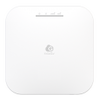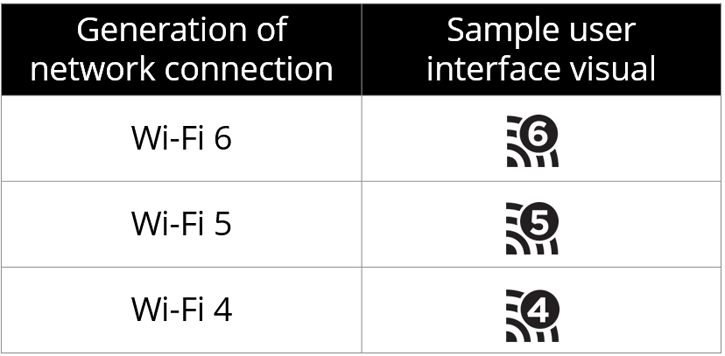Bits, Frames, and Packets
Access points
Why an access point? Here's the thing, in my house we have weird LAN on all floors. However a now all devices require LAN. The move towards WiFi 6 and especially the 5 Ghz band (AC/AX) in my home and workplace resulted in enhanced performance in terms of transfer speeds, as well as better handling of a large number of devices on the network. There is however one drawback, less range, especially when going through walls this can lead to wireless signal issues in a few areas in the house at the farthest points and for some, the garage. Here's where an Access point comes into play. EnGenius released their ECW220S WiFi 6 2x2 access point, which is identical to the ECW220 aside from antennas. The web is a dangerous place these days, at least when you leave devices unsecured. The EnGenius ECW220S is designed from the ground up with safety in mind. It has several mission critical security features, such as intrusion detection and mediation technologies. As stated and obvious, it features WiFi 6, so it can connect to a wide range of smart devices. It's also simple to set up and install because there's free cloud management software available. These are only a few of the issues we'll have to consider.
Hardware
Once opened up we see that the ecw220s has been fitted with a quad-core 1GHz Qualcomm IPQ6010 SoC, 512MB Samsung (2x SEC 134 K4B4G16) RAM and 128MB Storage. The switching handled by Qualcomm QCA8072, the two radio's are Qualcomm Atheros IPQ8072A (QCN5052) 802.11a/n/ac/ax 2×2:2 for 5 Ghz and Qualcomm Atheros IPQ8072A (QCN5021) 802.11b/g/n/ax 2×2:2 for the 2.4 Ghz band.
802.11ax = Wi-Fi 6
The 802.11ax standard a big thing for Wi-Fi. The .ax name is changing though as the Wi-Fi Alliance will get renamed to Wi-Fi 6. They advance on that as 802.11ac and 802.11n will be named Wi-Fi 5 and 4. The new name is introduced to make WIFI standards more easily recognizable. Let's face it, not everybody knows what 802.11ac means when I say it. Numbers are easy, and higher is better they must have thought.
- Wi-Fi 6 to identify devices that support 802.11ax technology
- Wi-Fi 5 to identify devices that support 802.11ac technology
- Wi-Fi 4 to identify devices that support 802.11n technology
6th gen WIFI (AX) technology combines the two and current 2.4 and 5 GHz frequencies. That technology is also known as Dual Band Simultaneous Streaming and, in theory, could achieve a proper 1.8 Gbit/s.
- Works with other Wi-Fi standards. Access points will be able to handle devices transmitting using 802.11a/b/g/n/ac.
- Increase by at least four times the average throughput per user in high-density scenarios, such as train stations, airports and stadiums. Now you can upload a picture or FaceTime in a flash, while on the go.
- The ability to use wider spectrum channels to achieve gigabit speeds and higher.
- Orthogonal Frequency Division Multiple Access (OFDMA) technology effectively allocates spectrum when you need it, so more users can be accommodated in the same channel bandwidth, both uploading and downloading. This allows many more users or devices to share a single 90 MHz or 160 MHz channel.
- There are a number of changes to the standard that mean using the spectrum more efficiently and more robust and reliable connections, including outdoors.
- 802.11ax introduces a scheme to reduce interference and use the spectrum even more efficiently called Spatial Reuse with Color Identifier. Each Wi-Fi access point and client transmits data with a unique identifier called a “color.” Wi-Fi “listens” for interference before sending data, and will back off if it senses data in the band. With 802.11ax, when an access point or a client listens first before transmitting data, they are more aggressive if they hear data from a different color, since that data is going to a different AP further away from the client.
- Improved traffic flow and channel access
- Better power management for longer battery life
OFDMA is utilized with the EnGenius ECW220S to simplify data transmission and reception for customers. The channel capacity is separated into many resource units that are assigned to each client, allowing for far more efficient bandwidth use than was previously possible with the WiFi 5 standard. Additionally, beamforming is critical, as it focuses the signal on the individuals who can utilize it, rather than all over the place. MU-MIMO is also enabled, which enables the server to serve several clients concurrently if they have compatible WiFi adapters. What's intriguing, but not surprising, is that functionality exists for creating a mesh network by connecting many wireless access points. Along with combining several EnGenius APs into a single network, there is a means to extend the WiFi signal into hard-to-reach places. This is because support for 802.11r/k enables simple roaming between nodes. If you already have a Cloud platform, all access points can be on the same network.
| Specifications | |
| Standards | IEEE 802.11ax on 2.4 GHz IEEE 802.11ax on 5 GHz (Backward compatible with 802.11b/g/n/ac) 2.4 GHz Bluetooth Low Energy (BLE) Radio |
| Processor | Qualcomm® Quad-Core CPU ARM Cortex A53s @ 2.0GHz CPU |
| Antenna | 2 x 2.4 GHz: 4 dBi 2 x 5 GHz: 5 dBi |
| Scanning Radio | 1 x 2.4 GHz 1 x 5 GHz |
| Integrated Omni-Directional Antenna | BLE: 6 dBi |
| Physical Interface | 1 x 10/100/1000/2500 BASE-T, RJ-45 Ethernet Port1x DC Jack1 x Reset Button |
| LED Indicators | 1 x Power 1 x LAN 1 x 2.4 GHz 1 x 5 GHz 1 x Scanning Radio 1 x BLE |
| Power Source | Power-over-Ethernet: 802.3at Input12VDC /2A Power Adapter (Not Included) |
| Maximum Power Consumption | 12.8W |
| Wireless & Radio Specifications | |
| Operating Frequency | Dual-Radio Concurrent 2.4 GHz & 5 GHz |
| Operation Modes | AP, Mesh |
| Frequency Radio | 2.4 GHz: 2400 MHz ~ 2482 MHz 5 GHz: 5150 MHz ~ 5250 MHz, 5250 MHz ~ 5350 MHz, 5470 MHz ~ 5725 MHz, 5725 MHz ~ 5850 MHz |
| Transmit Power | Up to 22 dBm on 2.4 GHz to 22 dBm on 5 GHz (Maximum power is limited by regulatory domain) |
| Tx Beamforming (TxBF) | Yes |
| Radio Chains/Spatial Stream | 2x2:2 |
| SU-MIMO | Two (2) spatial streams SU-MIMO for 2.4GHz and two (2) spatial streams SU-MIMO for 5GHz up to 1,774Mbps wireless data rate to a single 11ax wireless client device under the both 2.4G Hz and 5GHz radio. |
| MU-MIMO | Two (2) spatial streams multiple (MU)-MIMO for up to 1,200 Mbps wireless data rate to transmit to two (2) stream MU-MIMO 11ax capable wireless client devices under 5GHz simultaneously. Two (2) multiple (MU)-MIMO for up to 574 Mbps wireless data rate to transmit to two-stream MUMIMO 11ax capable wireless client devices under 2.4GHz simultaneously. |
| Supported Data Rates (Mbps) | 802.11ax: 2.4 GHz: 9 to 574 (MCS0 to MCS11, NSS = 1 to 4) 5 GHz: 18 to 1200 (MCS0 to MSC11, NSS = 1 to 4) 802.11ac: 6.5 to 867 Mbps (MCS0 to MCS9, NSS = 1 to 4) 802.11n: 6.5 to 300 Mbps (MCS0 to MCS15) 802.11a/g: 6, 9, 12, 18, 36, 48, 54 802.11b: 1, 2, 5.5, 11 |
| Supported Radio Technologies | 802.11ax: Orthogonal Frequency Division Multiple Access (OFDMA)802.11b: Direct-sequence spread-spectrum (DSSS)802.11ac/a/g/n: Orthogonal Frequency Division Multiple (OFDM) |
| Channelization | 802.11ax supports high efficiency (HE) ?HE 20/40/80 MHz 802.11ac supports very high throughput (VHT) ?VHT 20/40/80 MHz 802.11n supports high throughput (HT) ?HT 20/40 MHz 802.11n supports very high throughput under the 2.4GHz radio ?VHT40 MHz (256-QAM) 802.11n/ac/ax packet aggregation: A-MPDU, A-SPDU Dynamic Frequency Selection (DFS) Certified |
| Supported Modulation | 802.11ax: BPSK, QPSK, 16-QAM, 64-QAM, 256-QAM, 1024-QAM802.11ac: BPSK, QPSK, 16-QAM, 64-QAM, 256-QAM802.11a/g/n: BPSK, QPSK, 16-QAM, 64-QAM802.11b: BPSK, QPSK, CCK |
| Management | |
| Multiple BSSID | 8 SSIDs for both 2.4GHz and 5GHz radios. |
| VLAN Tagging | Supports 802.1q SSID-to-VLAN TaggingCross-Band VLAN Pass-ThroughManagement VLAN |
| Spanning Tree | Supports 802.1d Spanning Tree Protocol |
| QoS (Quality of Service) | IEEE 802.11e compliant WMM |
| SNMP | v1, v2c, v3 |
| MIB | I/II, Private MIB |
| Wireless Security | WPA3 Enterprise WPA3-PSK (SAE) WPA3/WPA2-PSK Mixed WPA2 Enterprise WPA2 AES-PSK Hide SSID in Beacons MAC Address Filtering, up to 256 MACs per SSID Wireless STA (Client) Connected List SSH Tunnel Client Isolation |
| Wireless Monitoring | WIPS/WIDS Dedicated Dual-Band Radios Rogue AP & Device Detection RF Spectrum Analysis Zero-Wait DFS |
| Environmental & Physical | |
| Temperature Range | Operating: 32ºF~104ºF (0 ºC~40 ºC)Storage: -40 ºF~176 ºF (-40 ºC~80 ºC) |
| Humidity (non-condensing) | Operating: 90% or lessStorage: 90% or less |
| Device Dimensions & Weights | |
| ECW220 Device | Weight: 0.947 lbs (0.43kg) Length: 6.30" (160 mm) Width: 6.30" (160 mm) Height: 1.31" (33.2 mm) |
| Packaging | Weight: 1.28 lbs. (580 g)Length: 8.07" (205 mm)Width: 8.07" (205 mm)Height: 3.27" (83 mm) |
| Package Contents | 1 - ECW220S Cloud Managed Indoor Access Point 1 - Ceiling Mount Base (9/16? Trail) 1 - Ceiling Mount Base (15/16? Trail) 1 - Ceiling and Wall Mount Screw Kits 1 - Quick Installation Guide |
| Warranty | 2 Year |
| Certifications | CEFCCIC |


